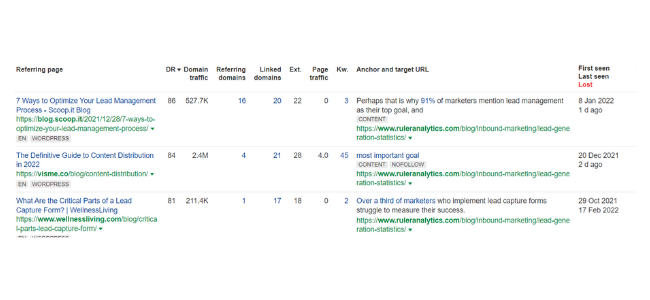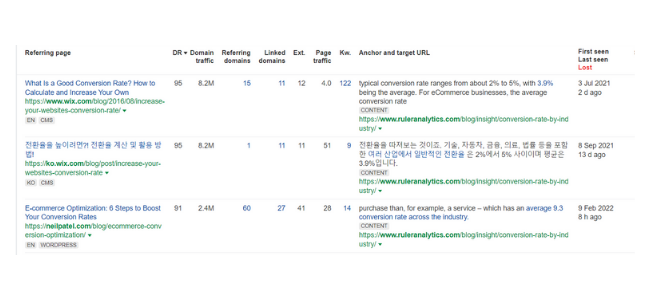Wondering how to improve your domain rating and not sure where to start? We walk you through how we did it here at Ruler and share our top tips.
Domain rating, or website authority, is an interesting metric to track when looking at the performance of your website.
While it’s clear to see the correlation between high-ranking content and high domain authority sites, it doesn’t mean it’s impossible to rank highly when your domain rating needs some work.
Back in 2020, our domain rating was stagnant; stuck at 55.
We wanted to improve this so we could compete for high difficulty keywords, get more traffic to our site and content and subsequently convert more website visitors.
Keep reading to learn:
So, let’s get stuck in.
Website authority or domain rating is an SEO concept created to understand the strength of a given campaign.
Domain rating is a ranking metric created by Ahrefs assigned to highlight the strength of a website’s backlink profile compared to others in their database. We use Ahrefs to better track our SEO performance and keyword rankings.
The rating assigns points out of 100 which considers the number and quality of links you get from other domains.
Domain rating is an important metric for marketers as it helps them understand the quality of their backlink profile. It can also be closely linked to your rankings and traffic.
Ahrefs say to think of DR as a relative term in the sense that it’s dependent not only on the number of sites with a high domain rating linking to you but also on how many other websites these sites link to as well.
Let’s use a quick example to explain.
Website A has a domain rating of 80 and links to 1,000 sites. Website B also has a domain rating of 80 but only links to 500 sites. According to Ahrefs, a link from website B would be more powerful than a link from website A.
In early 2021, we decided we wanted to focus on growing our domain rating. As we were writing organic content, it was becoming increasingly obvious that we were missing out on top rankings due to our lower domain rating.
How could we ever hope to rank 1st for highly competitive keywords when we’re competing against sites with a domain rating of 80+.
So, we decided to change it and get competitive. Here’s what we did…
To begin with, we looked at our strategy.
We had always been strong on organic content, but in 2021 we ramped it up to a whole new level.
We were creating a large amount of content; drilling down into our key pillars and hitting all stages of the funnel.
Related: Complete guide to customer journey stages
Previously, we had never really had a specific strategy to raise our domain rating.
And while we didn’t want it to be a main metric for our web content, we knew we wanted to improve it as a result of our work on organic content and SEO.
So for us, we broke it down into four key areas:
Each of these was key to us bettering our website performance; in particular, our SEO content. And actually, the points above are our main recommendations when it comes to improving your own domain rating, too.
We knew we were getting good traffic to the site, but we felt like we could do even better.
Our first step was creating an exhaustive content plan for the upcoming quarter where we plotted our new blogs, our existing blogs to be updated and community-led pieces of content we could work on.
Our first step was reaching out to a community of writers to start creating relevant content.
We began by using Help a Reporter Out, HARO, to build a community where we exchanged backlinks for insights.
This worked well for driving social engagement but we decided to take it a step further.
Instead of just asking questions for text responses, we started asking questions that helped us build our own stats.
So our content plan became simple.
We looked for statistic based keyword opportunities and started creating content that would rank well and that included a lot of these homemade stats.

From there, the backlinks started rolling in.
We evolved this strategy from creating stat-based blogs to sourcing our own data from our app itself.
From our own app, we created an amazing piece of content on conversion benchmark statistics broken down by industry type.
This piece has generated hundreds of backlinks and we ended up creating a blog post that ranks in the top 3 for highly competitive keywords like ‘average conversion rate’.

🚀 Pro Tip
Want to read the conversion benchmark report for yourself? It shares all the key conversion benchmarks by channel. Check it out here.
And from here, it’s just spiralled.
Lastly, we refocussed our content creation process. We generate high-quality content on a regular basis that focusses on each stage of the funnel for each of our major pillars.
We also regularly update our blog content so that we can keep it fresh, relevant and useful.
We’ve also introduced a new internal linking process to help us improve the ranking for key pages and encourage users to move down the funnel.
In the space of around 18 months, we’ve slowly built up our domain rating from 55 to 66 and it’s still growing.
Meanwhile, our traffic has increased 184% from Jan 2012 to March 2022. This is a huge jump for us as we already had a good solid base of traffic month on month.
And it doesn’t stop there.
Organic traffic has always been our main source of traffic and leads. And since implementing a strong content strategy, which in turn has improved our domain rating, our organic traffic has grown by 311% in the same time period.
Pretty impressive, right?
Our organic traffic has consistently brought us good leads. We’ve always had good content online that’s attracted high-quality leads.
However, since implementing this new content strategy, we’ve broadened our scope. We’re now seeing more leads come in through organic content, and they’re coming in via a wider variety of blogs.
🚀 Pro Tip
Want to know how we track how many clicks, leads, opps and sales we bring in month on month through organic blogs?
We use attribution! Here’s how Ruler can attribute revenue back to your marketing.
Of course, our domain rating isn’t the be-all and end-all for when it comes to driving these results. It’s one small part of a larger, long-term content strategy.
But, it has been incredibly exciting to see the results.
So now you know how we improved our domain rating. But you’re probably wondering how to make the same happen on your site.
These seven main tips will help you improve your domain rating:
Let’s look at them in more detail.
Depending on your industry and product or service, chances are you can create your own data and research. For us, we use our own app data, which certainly makes it easier.
But we also use crowd-sourced data and research.
Our community of marketers support us with survey content so that we can get stats and data on related topics.
Remember, check first to see if there’s any SEO value in the research topic you’re considering. There’s no point creating stats and data if there’s no existing interest.
The previous point and this one go hand in hand.
We created a number of stat-based blogs which have worked to great effect.
First, we looked into keyterms like ‘marketing statistics’ and drilled down into more niche, lower competition keywords.
This allowed us to identify some low-hanging fruit opportunities. You might find some keyword opportunities that you can easily deliver for a quick win.
Help a Reporter Out is a must for any marketer looking to grow their backlinks. You can pitch to marketers and journalists looking to write about particular topics. And there are enough topics for you to be sure to cover your business goals.

Remember, a pitch doesn’t guarantee inclusion.
We would suggest writing a blog for community writers first. Once you get a good idea of what you’re looking for for your own blog, you can use that to write stronger pitches.
As you engage with HARO and other sources, keep a list of your community. Marketers and writers are always looking to get more links.
Add them to a database – with permission – and use that to share out new content opportunities. This focus on your community could serve both ways, with your contacts offering you backlink opportunities too.
Regularly updating your blog content is key. But remember, you need to keep providing value. And not everyone likes reading blogs these days.
Look into how you can translate your content into other formats. Whether that’s a video, a podcast or an infographic. There are more opportunities for you by repurposing your content and disseminating it on more channels.
Don’t let yourself get bogged down by content writing and strategy. Technical SEO is still vital.
Be sure to regularly check key metrics like site speed, broken links, tags, meta description and so on.
Optimising these sends all the right signals to the search engine bots that your content is reliable and high-quality.
Internal linking within your own content is key. Not only can it drive people along their customer journey, but it can also help you build authority.
If you write blogs about Topic A, and you also have a landing page on the same topic, then link to it in those blogs.
It’ll help tell search engines that you’re a reputable voice and authority on that topic and in turn grow your traffic and SEO success.
Improving your domain rating takes time. And you need to remember, it’s not the be-all and end-all. While it can help you get more competitive on high difficulty keywords, it won’t necessarily bring in more leads and sales.
Focus on an overall content strategy that ties in the tips above and you can start lifting your traffic and your conversion rate on the whole.
Want to learn more about what we do? Follow us on social media, or subscribe to our newsletter. We share regular insight pieces like this one.